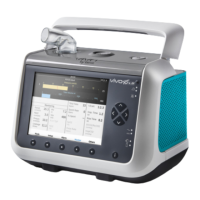The Vivo 45 LS with the CO
2
sensor is intended to measure CO
2
in the inspiratory and
expiratory gas.
The device is intended to be used in home, institution, hospitals and portable applica-
tions such as wheelchairs and gurneys. It may be used for both invasive and non-invasive
ventilation. The Vivo 45 LS is not intended to be used as an emergency transport or crit-
ical care ventilator.
1.4 Contraindications
• The use of the Vivo 45 LS is contraindicated for patients who need to be ventilated
with oxygen concentrations (FiO
2
) higher than achievable when combining inlet
from a low pressure oxygen source at 15 l/min with actual ventilator settings.
• Generally, after surgery, the surgeon should be consulted to avoid organ damage
and help determine ventilator parameters that do not adversely affect hemodynam-
ics or have a negative impact on the patient’s health status.
• In case of facial surgery, make sure to choose a suitable patient interface, in order to
avoid discomfort and injury.
Undesirable Side Effects
If the patient experiences chest discomfort, pain, severe headache or shortness of breath
while using the Vivo 45 LS, a physician or responsible clinician shall be contacted
immediately.
1.5 Intended Environment
The Vivo 45 LS is intended to be used in clinical settings (e.g. hospitals, sub-acute care
institutions), public spaces and home environments as well as during portable applica-
tions such as wheelchairs and personal family vehicles.
It is not intended for use during emergency transport or as a critical care ventilator.
1.6 Intended Users
This section describes the intended users of the Vivo 45 LS, their qualifications and their
related documents.
1.6.1 Respiratory Health Care Specialists
Health care professionals such as physicians and respiratory therapists are specialists
when it comes to operating mechanical ventilators.
They have a good understanding of the human respiratory system and a general under-
standing of mechanical ventilators.
14 Introduction
User manual
Doc. 007301 K-1

